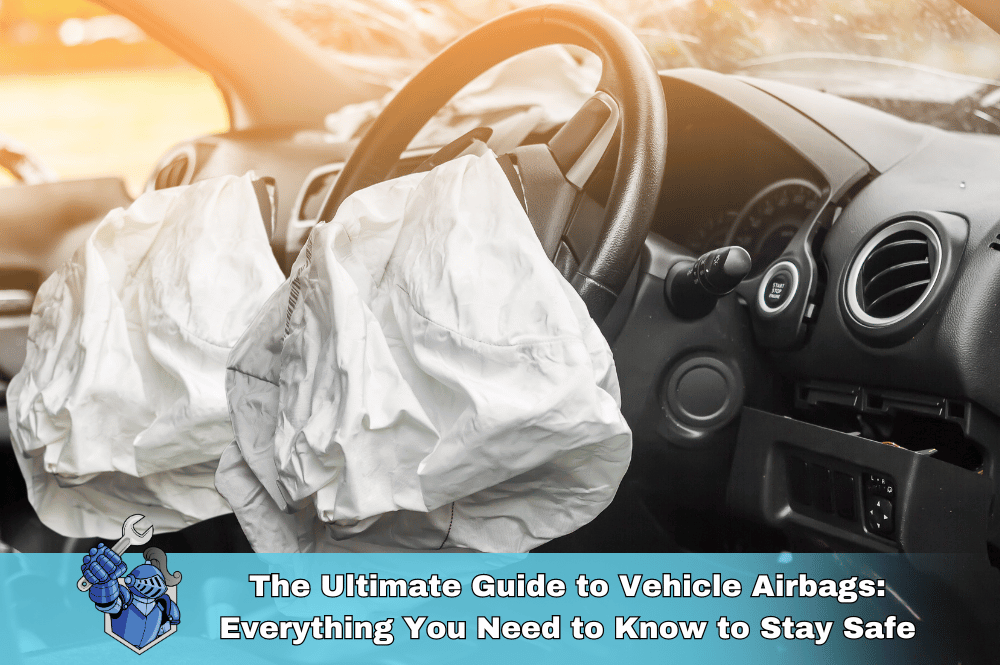Airbags are designed to rapidly inflate during a collision to provide a cushioning barrier between occupants and the vehicle's hard interior surfaces. They use sensors to detect a crash and trigger a chemical reaction that produces gas to inflate the airbag.
Vehicle airbags have become one of the most critical components in modern automotive safety. Designed to protect passengers during collisions, airbags have saved thousands of lives since their inception. However, there’s more to airbags than just inflating during an accident. Understanding how airbags work, their safety mechanisms, and essential maintenance tips will help ensure you stay safe on the road.
In this guide, we’ll delve into the mechanics of airbags, their deployment process, and how to maintain them, along with debunking common myths and answering frequently asked questions. Whether you're a new driver or a seasoned one, here's everything you need to know about vehicle airbags.
How Airbags Work
At its core, airbag safety is designed to prevent severe injuries during high-speed collisions by creating a cushion between passengers and hard surfaces inside the vehicle. In a collision, sensors detect rapid deceleration, which triggers the airbag to deploy almost instantly. Typically, this happens within 20 to 30 milliseconds of impact. The airbag is filled with nitrogen gas through a chemical reaction, creating a protective barrier that reduces the risk of head, neck, and chest injuries.
Airbag Deployment
Airbag deployment is not random; it depends on various factors such as vehicle speed, the direction of the impact, and seatbelt use. Not all airbags in a car may deploy during a crash—side airbags, for instance, will activate only during side collisions. Airbags are a secondary line of defense and are most effective when used in conjunction with seatbelts.
Types of Airbags
Today’s vehicles come with various types of airbags, each designed to protect different parts of the body during a crash. Here’s a brief overview:
- Frontal Airbags – The most common type, these airbags protect the driver and front passenger by deploying from the steering wheel and dashboard during head-on collisions.
- Side Airbags – These deploy from the sides of the seats or door panels, offering protection during side-impact crashes.
- Curtain Airbags – These are designed to protect the head and upper body, deploying from the ceiling to cover the windows.
- Knee Airbags – Deployed from under the dashboard, knee airbags prevent injuries to the legs and lower body.
- Rear-Seat Airbags – While less common, some vehicles are equipped with rear-seat airbags to protect passengers in the back seat.
Airbag Safety and Child Passengers
When it comes to child safety and airbags, it’s crucial to take precautions. Airbags are designed for adult passengers, and children under 13 should always ride in the back seat to avoid injuries caused by airbag deployment. Infants in rear-facing car seats should never be placed in the front seat, as the force of a deploying airbag can cause serious injury.
Airbag Maintenance and Replacement
Although airbags are designed to last the lifetime of a vehicle, airbag maintenance is essential, particularly if your car has been involved in an accident or is older. If your airbag light is illuminated on the dashboard, it’s a sign that the system may not work properly. In such cases, it’s important to have your vehicle inspected by a professional to determine if repairs or airbag replacement are necessary.
Moreover, do airbags expire? While airbags themselves don't "expire" in the traditional sense, older vehicles may have airbags that are outdated or non-functional. Regular vehicle check-ups can help ensure your airbags are still effective and ready to deploy in case of a collision.
Common Airbag Myths
There are several airbag myths circulating that can lead to misconceptions about their safety and functionality. Here are a few debunked:
- Myth: Airbags can suffocate you if they don't deflate quickly.
- Fact: Airbags are designed to deflate immediately after deployment to prevent suffocation or further injury.
- Myth: If you wear a seatbelt, you don’t need an airbag.
- Fact: Airbags and seatbelts are complementary safety systems. Both significantly reduce the risk of injury when used together.
Airbag Statistics and Injuries
According to the National Highway Traffic Safety Administration (NHTSA), airbags have saved more than 50,000 lives since their widespread implementation in the 1990s. However, while they are lifesaving devices, airbag injuries can still occur, especially if passengers are too close to the airbag when it deploys. Most injuries are minor, but in rare cases, severe injuries or fatalities can result, particularly if the airbag system malfunctions.
The Future of Airbag Technology
Advancements in airbag technology are making vehicles safer than ever. In the future, we can expect to see more intelligent airbag systems that adjust deployment force based on passenger size and weight, along with external airbags designed to protect pedestrians. As autonomous vehicles become more widespread, airbags may even change shape and placement to accommodate different seating arrangements.
Airbag Laws and Regulations
Vehicle manufacturers are required by law to equip all new cars with airbags in the front seats. Airbag laws and regulations vary by country, but most follow strict guidelines set forth by government safety agencies to ensure optimal protection for drivers and passengers. It’s important to be aware of the airbag system in your car and keep it well-maintained to comply with safety standards.
What to Do After an Airbag Deploys
If you’re involved in an accident and your airbag deploys, it’s essential to follow the correct steps afterward:
- Check for injuries – While airbags reduce the severity of injuries, they can still cause minor burns, cuts, or bruises.
- Exit the vehicle – Once it’s safe, move away from the car, especially if the crash caused severe damage.
- Seek professional inspection – After an airbag deployment, your car will likely need repairs, and the airbag system should be replaced by a qualified technician.
Noble Quote and Airbag Coverage
At Noble Quote, we understand the importance of keeping your vehicle safe. While we do not cover airbags, our extensive warranty plans ensure you’re protected from costly repairs related to other vital vehicle components. Whether you need coverage for your engine, transmission, or electrical systems, Noble Quote Warranty has a plan that works for you.
For more information on how our protection plans can safeguard your car, check out our Learning Center for in-depth articles and helpful tips.
Conclusion
Vehicle airbags are an essential safety feature that can dramatically reduce the risk of injury during an accident. Understanding how they work, maintaining them properly, and knowing what to do in case of deployment will help you stay safe on the road. While Noble Quote Auto Protection doesn’t cover airbags, we offer a range of warranties to protect your vehicle’s other vital systems. Visit our Learning Center to learn more about how we can help keep your car on the road without the worry of unexpected repair costs.
Frequently Asked Questions About Vehicle Airbags
How do vehicle airbags work?
What are the different types of airbags in a vehicle?
Common types of airbags include: Frontal airbags (driver and passenger) Side-impact airbags (torso and head) Knee airbags Curtain airbags Seatbelt airbags
How can I tell if my airbags are working properly?
The airbag warning light on your dashboard should illuminate briefly when you start your car and then turn off. If it stays on or flashes, it indicates a potential problem with the airbag system and you should have it checked by a qualified mechanic.
What should I do if my airbag deploys?
If your airbag deploys in an accident: Check yourself and others for injuries. If safe, move your vehicle to the side of the road. Contact emergency services if necessary. Have your vehicle and airbags inspected and repaired by a qualified professional.
Can airbags cause injuries?
While airbags are designed to save lives, they can cause minor injuries like abrasions or burns due to the rapid deployment. In rare cases, more serious injuries can occur, particularly if occupants are not properly positioned or restrained.
How often should I have my airbags serviced?
Airbags typically do not require regular maintenance, but it's a good idea to have them inspected as part of your vehicle's routine maintenance schedule or if the airbag warning light illuminates.
Are there any safety precautions I should take regarding airbags?
Yes, some important safety precautions include: Always wear your seatbelt properly. Children 12 and under should ride in the back seat. Infants and young children should be in rear-facing child safety seats as long as possible. Avoid placing objects on the dashboard or near airbags. Maintain a safe distance between yourself and the steering wheel (at least 10 inches).
Can I replace my airbags myself?
Airbag replacement is a complex procedure that should only be performed by a qualified mechanic. It involves handling potentially explosive components and ensuring the system is properly reconnected and calibrated.
Suggestions for you
Read MoreLet’s work together
Every week we showcase three charitable organizations that our donations are sent to. Our clients are able to choose which of these three will receive their gift when they add coverage to their vehicle...




